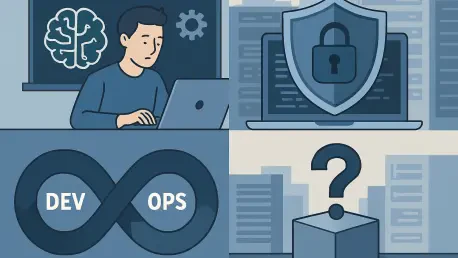In an era where artificial intelligence is reshaping the landscape of software development, a recent comprehensive study has unveiled a striking dichotomy that could define the future of DevSecOps. Released earlier this year, this global report highlights how AI, while accelerating coding processes, simultaneously introduces significant challenges that threaten to undermine productivity. Surveying thousands of professionals across IT operations, security, and development, the findings point to a critical tension between innovation and inefficiency. Dubbed the “AI Paradox,” this phenomenon captures the dual nature of AI as both a catalyst for speed and a source of new bottlenecks. As organizations strive to harness the power of intelligent systems, the insights from this report serve as a wake-up call, urging a reevaluation of tools, processes, and workforce readiness to navigate the complexities ahead.
Unpacking the AI Paradox in Software Development
Navigating the Speed-Efficiency Dilemma
The core of the AI Paradox lies in the stark contrast between AI’s ability to turbocharge coding and the inefficiencies it inadvertently creates. According to the study, which polled over 3,000 DevSecOps professionals, teams lose an average of seven hours per member each week due to fragmented processes. These inefficiencies stem from poor communication across functions, limited knowledge sharing, and the reliance on disconnected toolchains. A significant 60% of respondents reported using more than five tools for development, while nearly half juggle over five AI-specific tools, leading to a sprawl that hampers progress. Despite the rapid deployment cycles—82% of organizations push to production weekly—these barriers prevent full utilization of AI’s potential. The data paints a clear picture: while AI promises faster outputs, the lack of cohesive systems often negates those gains, leaving teams grappling with operational friction.
The Push for Integrated Platforms
Addressing the inefficiencies highlighted by the AI Paradox requires a fundamental shift in approach, with many professionals advocating for a unified solution. An overwhelming 85% of those surveyed believe that adopting a platform engineering strategy—integrating AI orchestration, governance, and compliance—could unlock significant productivity gains. Such an approach would streamline the disparate tools currently in use, reducing the cognitive load on teams and fostering better collaboration. The report underscores that without this integration, the benefits of AI risk being overshadowed by compliance challenges and tool fragmentation. As organizations look to the coming years, particularly toward 2026 and beyond, the consensus is that cohesive platforms are not just beneficial but essential. This shift represents a strategic pivot, aiming to transform AI from a source of complexity into a reliable driver of efficiency across DevSecOps workflows.
AI’s Broader Impact on Workforce and Innovation
Redefining Roles and Team Dynamics
Far from replacing human engineers, AI appears poised to expand the need for skilled professionals within DevSecOps, challenging common fears of job displacement. The report reveals that 76% of respondents anticipate an increase in engineering roles as AI simplifies coding tasks, necessitating greater oversight of AI-generated outputs at scale. Additionally, a striking 87% view AI adoption as a means to future-proof their careers, while 83% expect their roles to evolve significantly within the next five years. However, this optimism comes with a caveat: the same percentage of professionals expressed a desire for more organizational support in upskilling to adapt to these changes. This reflects a broader trend where AI reshapes team structures, creating opportunities for growth while placing pressure on individuals to continuously learn and adapt to new paradigms in software development.
Balancing Human Oversight with AI Adoption
While AI adoption is near-universal—with 97% of respondents either using or planning to integrate it into their workflows—trust in fully autonomous systems remains limited. Only 37% of professionals would rely on AI for daily tasks without human review, underscoring persistent concerns about reliability. A notable 73% reported issues stemming from “vibe coding,” where natural language prompts are used without a deep understanding of the resulting code, often leading to errors. Furthermore, 88% of those surveyed emphasized that human qualities like creativity and innovation remain irreplaceable, positioning AI as a supportive tool rather than a substitute. This balanced perspective highlights the importance of maintaining human oversight, ensuring that AI enhances rather than dictates the development process. As adoption continues to grow, striking this balance will be crucial for sustainable innovation.
Reflecting on AI’s Dual Nature
Lessons from a Transformative Era
Looking back, the detailed findings from this year’s global DevSecOps report paint a nuanced picture of AI as both a powerful enabler and a source of operational challenges. The inefficiencies costing teams hours each week stand out as a stark reminder of the need for streamlined systems, while the widespread belief in platform engineering offers a hopeful path forward. The anticipation of growing engineering roles, coupled with the clear demand for upskilling, underscores how AI reshapes workforce dynamics in profound ways. Meanwhile, the cautious approach to AI reliability and the emphasis on human creativity reflect a mature understanding of technology’s limits. These insights collectively capture the essence of the AI Paradox, revealing a landscape where promise and complexity coexist.
Charting the Path Ahead
As the industry reflects on these revelations, the next steps become evident: organizations need to prioritize integrated platforms to mitigate tool sprawl and compliance hurdles. Investing in workforce development emerges as equally critical, ensuring professionals are equipped to handle AI’s evolving demands. Beyond immediate solutions, fostering a culture of collaboration between human ingenuity and machine efficiency promises to address the paradox at its core. Looking toward future innovations, particularly in the years following 2025, the focus should remain on creating adaptable systems that support both rapid development and rigorous oversight. By embracing these strategies, the DevSecOps community can transform AI from a source of friction into a cornerstone of sustainable progress.









